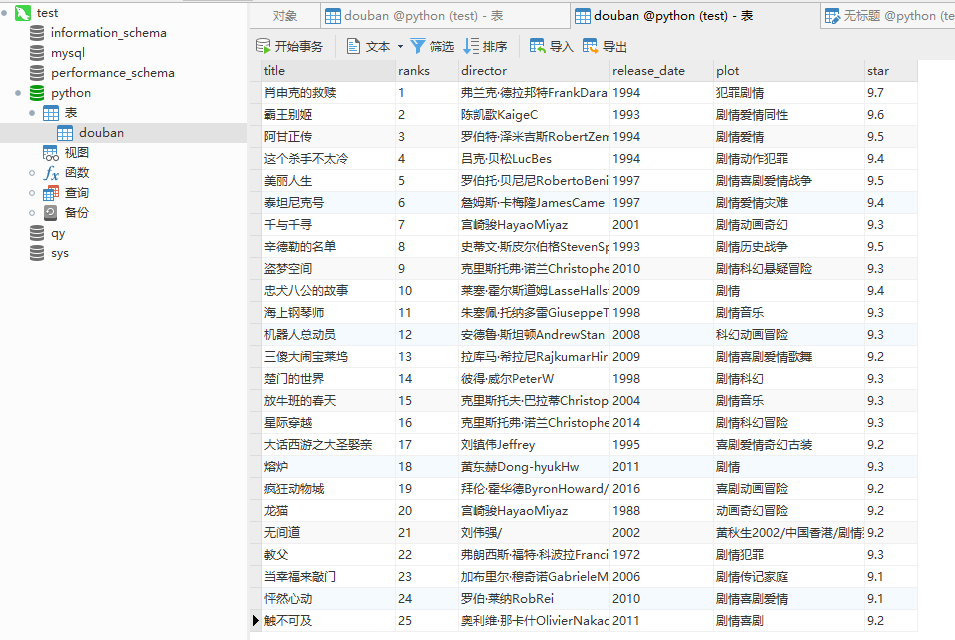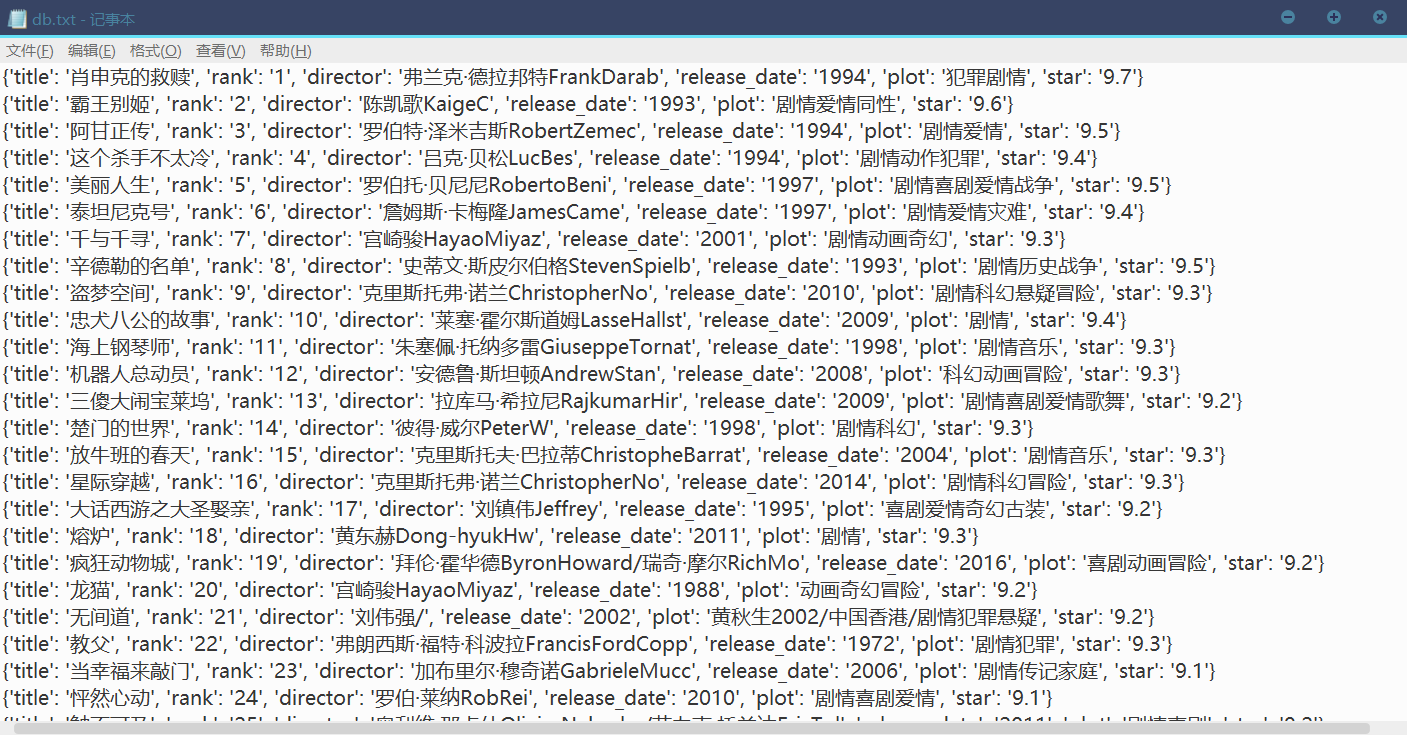上一节我们通过数据分析,找到了我们想要的内容,我们这一节就把这些内容保存到数据库中,来方便我们随时查看。
本节我们采用PyMySQL数据库以及txt文件两种方式来保存数据。
1. 完整代码
1 2 3 4 5 6 7 8 9 10 11 12 13 14 15 16 17 18 19 20 21 22 23 24 25 26 27 28 29 30 31 32 33 34 35 36 37 38 39 40 41 42 43 44 45 46 47 48 49 50 51 52 53 54 55 56 57 58 59 60 61 62 63 | import reimport requestsimport pymysqlfrom bs4 import BeautifulSoupqy = open('C:/Users/轻烟/Desktop/db.txt',mode='a',encoding='utf-8')#这里是要存入的文件目录for i in range(1): headers = {#这里模拟浏览器进行访问 'user-agent': 'Mozilla/5.0 (Windows NT 6.1; Win64; x64) AppleWebKit/537.36 (KHTML, like Gecko) Chrome/52.0.2743.82 Safari/537.36', 'Host': 'movie.douban.com' } res = 'https://movie.douban.com/top250?start='+str(25*i)#25次 r = requests.get(res, headers=headers, timeout=10)#设置超时时间 soup = BeautifulSoup(r.text, "html.parser")#设置解析方式,也可以使用其他方式。 div_list = soup.find_all('div', class_='item') movies = [] for each in div_list: movie = {} moviename = each.find('div', class_='hd').a.span.text.strip() movie['title'] = moviename rank = each.find('div', class_='pic').em.text.strip() movie['rank'] = rank info = each.find('div', class_='bd').p.text.strip() info = info.replace('\n', "") info = info.replace(" ", "") info = info.replace("\xa0", "") director = re.findall(r'[导演:].+[主演:]', info)[0] director = director[3:len(director) - 6] movie['director'] = director release_date = re.findall(r'[0-9]{4}', info)[0] movie['release_date'] = release_date plot = re.findall(r'[0-9]*[/].+[/].+', info)[0] plot = plot[1:] plot = plot[plot.index('/') + 1:] plot = plot[plot.index('/') + 1:] movie['plot'] = plot star = each.find('div', class_='star') star = star.find('span', class_='rating_num').text.strip() movie['star'] = star movies.append(movie) print(movie,file=qy)#保存到文件中con = pymysql.connect(host = 'localhost', user = 'root',password = '123456',database ='python',charset = 'utf8',port = 3306)print('连接成功->')cursor = con.cursor()#创建一个游标print('开始创建表->')cursor.execute("""create table douban ( title char(40), ranks char(40), director char(40), release_date char(40), plot char(100), star char(40)) """)print('完成表的创建,开始插入数据->')#下面开始插入数据for i in movies: cursor.execute("insert into douban(title,ranks,director,release_date,plot,star) " "values(%s,%s,%s,%s,%s,%s)",(i['title'],i['rank'],i['director'], i['release_date'],i['plot'],i['star']))print('插入数据完成')cursor.close()con.commit()con.close() |
2. 代码分析
爬虫部分的代码我们在上一节已经分析过了,这一节我们主要来分析数据库部分。
首先是连接数据库,相关信息要和自己的数据库相对应,详细连接方式可以参考前面的数据库章节。
1 2 3 4 | con = pymysql.connect(host = 'localhost', user = 'root',password = '123456',database ='python',charset = 'utf8',port = 3306)print('连接成功->')cursor = con.cursor()#创建一个游标 |
然后创建一个表来保存这些数据
1 2 3 4 5 6 7 8 9 | print('开始创建表->')cursor.execute("""create table douban ( title char(40), ranks char(40), director char(40), release_date char(40), plot char(100), star char(40)) """) |
由于我们已经把数据保存在了名为movies的列表中,我们遍历这个列表来插入数据即可插入的时候需要注意,前面数据库章节中插入数据是直接在values中用引号来完成,这里因为我们插入的是变量,不是string类型,因此我们要用占位符来插入数据,插入的格式如下。
1 2 3 4 | for i in movies: cursor.execute("insert into douban(title,ranks,director,release_date,plot,star) " "values(%s,%s,%s,%s,%s,%s)",(i['title'],i['rank'],i['director'], i['release_date'],i['plot'],i['star'])) |
这样就完成了数据的保存,我们可以在数据库中直接来浏览这些信息,这样就完成了数据的保存。
3. 运行结果
数据库文件:

txt文件中:

4. 总结
在这个例子中,我们结合了爬虫、BeautifulSoup和数据库三个部分,数据检查使用的比较少了解一下即可,爬虫项目大致就是这样一个流程,当然这个只是一个比较基础的爬虫练习,如果有兴趣的同学可以参考下面的网站去找一个项目动手练习:https://www.jb51.net/article/164829.htm。
C语言网提供由在职研发工程师或ACM蓝桥杯竞赛优秀选手录制的视频教程,并配有习题和答疑,点击了解:
一点编程也不会写的:零基础C语言学练课程
解决困扰你多年的C语言疑难杂症特性的C语言进阶课程
从零到写出一个爬虫的Python编程课程
只会语法写不出代码?手把手带你写100个编程真题的编程百练课程
信息学奥赛或C++选手的 必学C++课程
蓝桥杯ACM、信息学奥赛的必学课程:算法竞赛课入门课程
手把手讲解近五年真题的蓝桥杯辅导课程